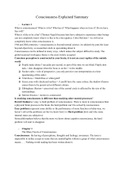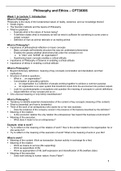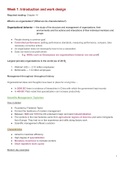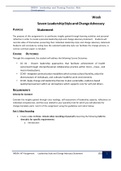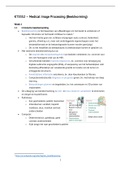Global Virtual Teams
Module 1
In GVT, evidence- based application is critical
Global Virtual Teams: working across teams, different:
- Language
- Culture
- Geographical
- Structural
- Temporal (time zone)
→ temporary, culturally diverse, geographically dispersed and electronically
communicating work groups → bound for common purpose
50% of organisations use GVTs extensively → 79% of knowledge workers
always/frequently work in dispersed teams.
Why GVT:
- Better utilisation of talent
- Staffing flexibility → meet market & employee demands
- Pooling insights for global marketplace understanding & decision making
- Better problem solving & innovation capabilities
Case - Us vs Them
Social categorization = extent to which teams are divided in subgroups, creating
ingroups (a subgroup one in part of) and outgroups (subgroup one is not part of) based
on perceived differences between members
Can create
- dislike/distrust, stereotypes/de-individualize, apply dispositional (vs contextual)
attribution
Faultlines = situation when differences in a team are aligned in a way that makes easy
division in subgroups possible
- Comparative fit
- Normative fit (norms in behaviour)
- Cognitive (knowledge) accessibility
→ power+ status differences
Implications of Us vs Them:
- Reduced identification with team as a whole
, - Lack of trust
- Increased interpersonal conflict
- Lack of cooperation
Mutual knowledge problem = interactants lack a shared understanding of important
information (task, context, attributes, strategies, procedures)
→ essential prerequisite for communication
Implications:
- Reduced info elaboration
- Incomplete info
- Reduced coordination
- biassed/ suboptimal decision making
Type of knowledge:
- Direct knowledge
- Reflected knowledge
Mechanisms through which mutual knowledge is established:
- Direct knowledge ( is created in the course of firsthand experience with
individual)
- Interactional dynamics ( In lieu of direct knowledge, mutual knowledge can be
established through interaction)
, - Category membership ( people make assumptions about others' knowl- edge on
the basis of the social categorizations they apply to them)
GVTs success depends on all team members
Relative roles or structure, hierarchical & shared leadership:
Team performance of teams with high virtuality increases when there are high
structural supports compared to low virtuality teams for which it doesn’t matter
Team design vs Team leadership
, Trust building in GVTs in challenging yet..
Depends on trust types, temporal dynamics, context, homogenous vs heterogenous,
management interventions
Technology is semi at the core of GVT, some caveats (limitations):
- Creating a shared context
- Intentional use of media
- Perceived proximity
Readings + guiding questions:
Cramton 2001 p346-371
This paper examines how the use of communication technologies to support
cooperative work interacts with the problem of establishing mutual knowledge in
teams. It further asks:
1. How does geographic dispersion of team members affect the mutual
knowledge problem?
Module 1
In GVT, evidence- based application is critical
Global Virtual Teams: working across teams, different:
- Language
- Culture
- Geographical
- Structural
- Temporal (time zone)
→ temporary, culturally diverse, geographically dispersed and electronically
communicating work groups → bound for common purpose
50% of organisations use GVTs extensively → 79% of knowledge workers
always/frequently work in dispersed teams.
Why GVT:
- Better utilisation of talent
- Staffing flexibility → meet market & employee demands
- Pooling insights for global marketplace understanding & decision making
- Better problem solving & innovation capabilities
Case - Us vs Them
Social categorization = extent to which teams are divided in subgroups, creating
ingroups (a subgroup one in part of) and outgroups (subgroup one is not part of) based
on perceived differences between members
Can create
- dislike/distrust, stereotypes/de-individualize, apply dispositional (vs contextual)
attribution
Faultlines = situation when differences in a team are aligned in a way that makes easy
division in subgroups possible
- Comparative fit
- Normative fit (norms in behaviour)
- Cognitive (knowledge) accessibility
→ power+ status differences
Implications of Us vs Them:
- Reduced identification with team as a whole
, - Lack of trust
- Increased interpersonal conflict
- Lack of cooperation
Mutual knowledge problem = interactants lack a shared understanding of important
information (task, context, attributes, strategies, procedures)
→ essential prerequisite for communication
Implications:
- Reduced info elaboration
- Incomplete info
- Reduced coordination
- biassed/ suboptimal decision making
Type of knowledge:
- Direct knowledge
- Reflected knowledge
Mechanisms through which mutual knowledge is established:
- Direct knowledge ( is created in the course of firsthand experience with
individual)
- Interactional dynamics ( In lieu of direct knowledge, mutual knowledge can be
established through interaction)
, - Category membership ( people make assumptions about others' knowl- edge on
the basis of the social categorizations they apply to them)
GVTs success depends on all team members
Relative roles or structure, hierarchical & shared leadership:
Team performance of teams with high virtuality increases when there are high
structural supports compared to low virtuality teams for which it doesn’t matter
Team design vs Team leadership
, Trust building in GVTs in challenging yet..
Depends on trust types, temporal dynamics, context, homogenous vs heterogenous,
management interventions
Technology is semi at the core of GVT, some caveats (limitations):
- Creating a shared context
- Intentional use of media
- Perceived proximity
Readings + guiding questions:
Cramton 2001 p346-371
This paper examines how the use of communication technologies to support
cooperative work interacts with the problem of establishing mutual knowledge in
teams. It further asks:
1. How does geographic dispersion of team members affect the mutual
knowledge problem?

